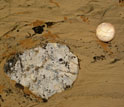News Release 10-037
Scientists Find Signs of "Snowball Earth" Amidst Early Animal Evolution
New evidence hints at global glaciation 716.5 million years ago

A diagram showing two theories on glaciation on early Earth (from 716.5 to 630 million years ago).
March 4, 2010
This material is available primarily for archival purposes. Telephone numbers or other contact information may be out of date; please see current contact information at media contacts.
Geologists have found evidence that sea ice extended to the equator 716.5 million years ago, bringing new precision to a "snowball Earth" event long suspected to have taken place around that time.
Funded by the National Science Foundation (NSF) and led by scientists at Harvard University, the team reports on its work this week in the journal Science.
The new findings--based on an analysis of ancient tropical rocks that are now found in remote northwestern Canada--bolster the theory that our planet has, at times in the past, been ice-covered at all latitudes.
"This is the first time that the Sturtian glaciation has been shown to have occurred at tropical latitudes, providing direct evidence that this particular glaciation was a 'snowball Earth' event," says lead author Francis Macdonald, a geologist at Harvard University.
"Our data also suggest that the Sturtian glaciation lasted a minimum of five million years."
According to Enriqueta Barrera, program director in NSF's Division of Earth Sciences, which supported the research, the Sturtian glaciation, along with the Marinoan glaciation right after it, are the greatest ice ages known to have taken place on Earth. "Ice may have covered the entire planet then," says Barrera, "turning it into a 'snowball Earth.'"
The survival of eukaryotes--life forms other than microbes such as bacteria--throughout this period suggests that sunlight and surface water remained available somewhere on Earth's surface. The earliest animals arose at roughly the same time.
Even in a snowball Earth, Macdonald says, there would be temperature gradients, and it is likely that sea ice would be dynamic: flowing, thinning and forming local patches of open water, providing refuge for life.
"The fossil record suggests that all of the major eukaryotic groups, with the possible exception of animals, existed before the Sturtian glaciation," Macdonald says. "The questions that arise from this are: If a snowball Earth existed, how did these eukaryotes survive? Did the Sturtian snowball Earth stimulate evolution and the origin of animals?"
"From an evolutionary perspective," he adds, "it's not always a bad thing for life on Earth to face severe stress."
The rocks Macdonald and his colleagues analyzed in Canada's Yukon Territory showed glacial deposits and other signs of glaciation, such as striated clasts, ice-rafted debris, and deformation of soft sediments.
The scientists were able to determine, based on the magnetism and composition of these rocks, that 716.5 million years ago the rocks were located at sea-level in the tropics, at about 10 degrees latitude.
"Climate modeling has long predicted that if sea ice were ever to develop within 30 degrees latitude of the equator, the whole ocean would rapidly freeze over," Macdonald says. "So our result implies quite strongly that ice would have been found at all latitudes during the Sturtian glaciation."
Scientists don't know exactly what caused this glaciation or what ended it, but Macdonald says its age of 716.5 million years closely matches the age of a large igneous province--made up of rocks formed by magma that has cooled--stretching more than 1,500 kilometers (932 miles) from Alaska to Ellesmere Island in far northeastern Canada.
This coincidence could mean the glaciation was either precipitated or terminated by volcanic activity.
Macdonald's co-authors on the Science paper are Phoebe A. Cohen, David T. Johnston, and Daniel P. Schrag at Harvard; Mark D. Schmitz and James L. Crowley of Boise State University; Charles F. Roots of the Geological Survey of Canada; David S. Jones of Washington University in St. Louis; Adam C. Maloof of Princeton University; and Justin V. Strauss.
This work also was supported by the Polar Continental Shelf Project.
-NSF-
-
Glaciation at tropical latitudes provides evidence of a "snowball Earth."
Credit and Larger Version -
Ancient tropical rocks now found in northwestern Canada show evidence of past ice cover.
Credit and Larger Version -
Scientists wonder if a long-ago "snowball Earth" stimulated the evolution of animals.
Credit and Larger Version -
The researchers' findings appear in the March 5, 2010 issue of the journal Science.
Credit and Larger Version
Media Contacts
Cheryl Dybas, NSF, (703) 292-7734, email: cdybas@nsf.gov
Steve Bradt, Harvard University, (617) 275-3628, email: steve_bradt@harvard.edu
The U.S. National Science Foundation propels the nation forward by advancing fundamental research in all fields of science and engineering. NSF supports research and people by providing facilities, instruments and funding to support their ingenuity and sustain the U.S. as a global leader in research and innovation. With a fiscal year 2023 budget of $9.5 billion, NSF funds reach all 50 states through grants to nearly 2,000 colleges, universities and institutions. Each year, NSF receives more than 40,000 competitive proposals and makes about 11,000 new awards. Those awards include support for cooperative research with industry, Arctic and Antarctic research and operations, and U.S. participation in international scientific efforts.
Connect with us online
NSF website: nsf.gov
NSF News: nsf.gov/news
For News Media: nsf.gov/news/newsroom
Statistics: nsf.gov/statistics/
Awards database: nsf.gov/awardsearch/
Follow us on social
Twitter: twitter.com/NSF
Facebook: facebook.com/US.NSF
Instagram: instagram.com/nsfgov




